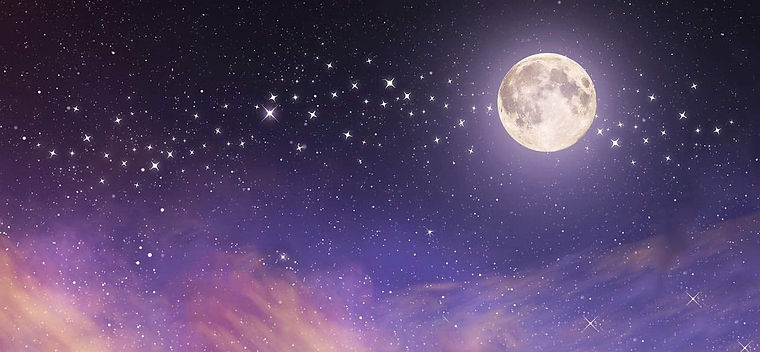Ultimate Introduction to Ancient Chinese Astrology and Horoscope — Three Enclosures, Four Symbols, Twenty-eight Lunar Mansions
Chinese astrology and horoscope began by observing the Seven Luminaries in ancient times and evolved into a comprehensive system, intricately weaving together cosmic wisdom and earthly destinies.
Comprising the Three Enclosures, Four Symbols, and Twenty-eight Lunar Mansions, ancient Chinese astrology scrutinizes the movements of stars and their influences on the earth, unveiling the intricate connections between the heavens and human existence.

Seven Luminaries
Since Neolithic times, people have marveled at the beautiful starry, velvety, and tranquil skies at night.
Gradually, they discovered that seven celestial beings possess exceptional luminosity and tremendous influence.
Therefore, they named them the Seven Luminaries (七曜): the Sun, Moon, Venus, Jupiter, Mercury, Mars, and Saturn.
To connect their movements and influences to the changes of seasons, sunlight, rain, and wind, they needed to establish a proper and accurate method for research and recording.

Ancient Chinese Astronomy and the Laws of Nature
In addition to the Seven Luminaries, numerous other stars illuminate the sky.
Based on their positions, these stars were divided into various groups, each representing a specific area, similar to coordinates, to observe and track the movements of the Seven Celestials and record dates.

Ancient Chinese Astronomical Chart Created in 1193, the Suzhou Star Chart.
Three Enclosures in the Center
The stars in the central celestial sphere around the North Celestial Pole make up the Three Enclosures, which include:
-
Purple Forbidden 紫薇垣
-
Supreme Palace 太微垣
-
Heavenly Market 天市垣

Three Enclosures in Ancient Chinese Astrology, Picture from Yi Dao Cheng Ming.
Four Symbols and Twenty-eight Lunar Mansions in the Circle
The stars surrounding the celestial sphere are divided into four cardinal directions, each represented by a divine:
Each of the Four Symbols contains seven constellations, resulting in a total of 28 constellations.

Three Enclosures, Four Symbols and Twenty-eight Lunar Mansions in Ancient Chinese Astrology, Picture from Xu Gang.
Why are the 28 Constellations named the 28 Lunar Mansions?
The ancient Chinese astrology system encompassed more than just the observation of the moon's movement.
However, the 28 constellations situated along the ecliptic represent the path where the moon 'resides' in succession each night during the lunar month.
Furthermore, as the moon is the most luminous and prominent celestial body during the night, these constellations are aptly named the 28 Lunar Mansions.

Origin and Development
The formation of the entire astrology system was a lengthy process that involved observation and knowledge accumulated over generations.
Therefore, the exact origin is not clear.
However, it can be established that the ancient Chinese astronomy system had already taken shape during the Warring States Period (403 BC — 221 BC).

The Earliest Existing Artifact (Lacquer Suitcase) Noted the 28 Lunar Mansions and Their Names, Unearthed from the Tomb of Marquis Yi of Zeng (about 477 BC — 433 BC), Preserved in the Hubei Museum.
As time passed, the classification of asterisms within the system underwent changes, and additional stars were discovered and documented over time.
Furthermore, due to the unavailability of visibility of the South Celestial Pole to ancient Chinese observers, the Southern Asterisms remained unknown until their introduction in the late Ming Dynasty (1368 — 1644).
Astrology in Divination
In ancient times, people believed in the interconnectedness of the entire universe.
They believed celestial phenomena in the sky could reflect and foreshadow human affairs on Earth.
This included observations of the colors and brightness of stars, the movements and positions of the Seven Luminaries and comets in different mansions, and more.
Throughout history, the signs revealed by the heavens were widely believed and followed, from emperors to common people.
Different constellations were revered at specific times, and astrology was used to divine upcoming events and make important decisions.
In official historical documentation, many significant events and natural disasters were recorded alongside astrological phenomena.

Ancient Astronomical Observatory Built from 1276 to 1279 on Mount Song, Picture from Official Site of Songshan.
28 Constellations in Chinese Horoscope
Because of the significance of astrology, the 28 Constellations were deified and visualized no later than the Tang (618 — 907) and Song (960 — 1279) dynasties.
In conjunction with Yin-Yang and the Five Elements Theory, 28 deities and 28 animals were assigned to guard each constellation.

Part of "Divinities of the Five Planets and Twenty-Eight Constellations" Painted by Liang Lingzan (about 690 — 757), is now Preserved in the Osaka City Museum of Fine Arts.
As part of the universe, humans are believed to be influenced by the surrounding nature, including the energy of the asterisms.
Furthermore, since the 28 Lunar Mansions represent the places where the moon "stays" each day, they hold temporal significance by connecting to people's birthdays. This correlation links one's personality, love life, career, and relationship patterns with others.
Additionally, they have also formed a system that denotes auspicious and inauspicious activities for each day.
